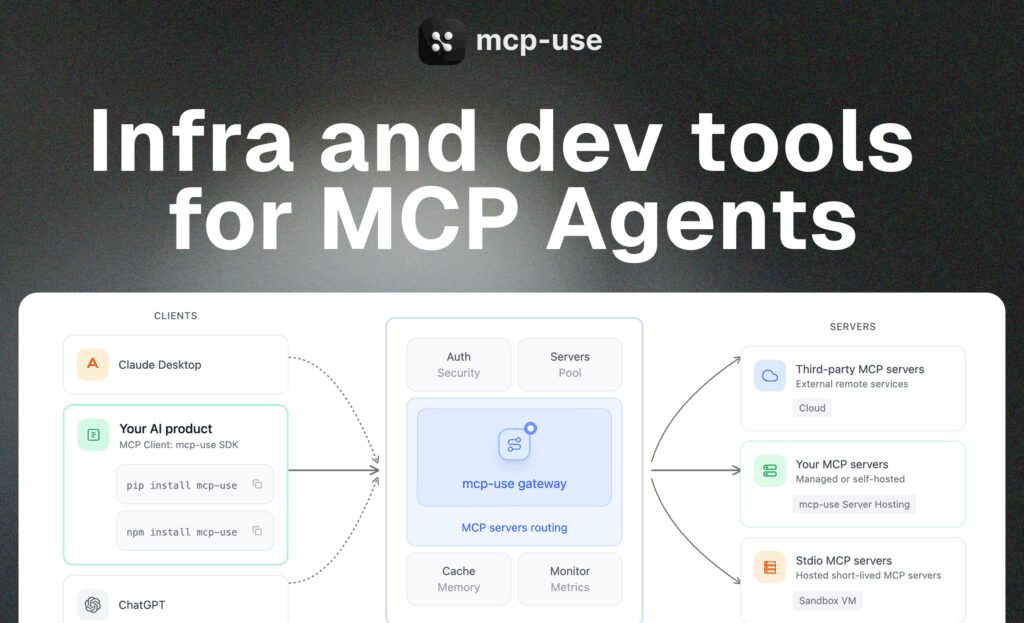AI Native Product Insights – 2025W33

Based on Product Hunt Weekly Leaderboard data, we’ve curated a selection of AI Native applications that demonstrate how AI is being built into the core of modern products. These AI Native solutions showcase new developments in functionality and are exploring fresh ways of human-AI interaction. Let’s dive into these AI Native applications.
1. mcp-use
🚀 Product Overview, is an open-source SDK and cloud platform designed to simplify the development and deployment of custom AI agents using MCP servers. It offers a modular architecture combining SDK, control plane, and managed hosting to enable teams to build production-ready AI-native features faster.
📋 More Details
Created by a YC-backed team,, tackles fragmented MCP server setups, enabling safe, observable AI agent execution. It provides unified configuration, access control, audit logging, and sandbox environments. Major organizations like NASA, NVIDIA, and SAP already use it to develop agentic applications across varied environments.
📊 Evaluation
AI Native Application Modernization: 91/100. is a fully AI-native infrastructure layer purpose-built for deployable agentic systems. Its integration-first design ensures that generative AI agents are not auxiliary but central to product functionality and architecture.
🔗 Website
https://, .com/?ref=producthunt

2. Sellinger AI
🚀 Product Overview, is an autonomous, end-to-end LinkedIn outreach platform powered by generative AI. It engages leads through realistic, personalized conversations, handles nuanced responses, and manages follow-ups—filling calendars without manual effort.
📋 More Details
Born out of the frustration with static outreach methods and high SDR costs,, acts as a team of AI agents. These agents research prospects, generate human-quality dialogue, adapt to context, and drive conversations across sales, recruiting, fundraising, and partnerships—at scale and without fatigue.
📊 Evaluation
AI Native Application Modernization: 91/100. is deeply AI-native, with generative agents at its core executing full-cycle conversations across thousands of concurrent threads. It’s not an AI plug-in—it is AI as the product.
🔗 Website
https://sellinger.ai/?ref=producthunt

3. v0.app by Vercel
🚀 Product Overview
v0.app is an AI-powered assistant that helps users collaboratively design, build, and scale full-stack web applications. It offers a natural language interface for creating front-ends and managing workflows across web projects.
📋 More Details
Evolving from v0.dev, the platform now features agentic capabilities — from code generation to reasoning, task planning, debugging, file reading and even UI conceptualisation. It can collaborate with users or autonomously execute full workflows, and integrates with existing tools, all offered for free.
📊 Evaluation
AI Native Application Modernization: 91/100. Built as an AI-first platform, v0.app leverages generative AI as its core interface and logic engine. Tasks such as structural planning, error detection, code generation, and research are performed by autonomous or collaborative AI agents, highlighting its native AI integration.
🔗 Website
https://v0.app/?ref=producthunt

4. Inworld Runtime
🚀 Product Overview, is a purpose-built AI-native backend designed to help teams rapidly scale consumer applications—from prototype to millions of users—without the usual operational overhead. It offers a no-code environment and instant deployment capabilities optimized for real-world usage.
📋 More Details
Originally developed to serve major partners like NVIDIA and Disney, Runtime addresses key challenges in bringing AI features to production, including long development cycles, high maintenance burdens, and failed product bets. Its architecture includes adaptive graphs, automated MLOps, and live experimentation tools via a single API, already powering apps with millions of users.
📊 Evaluation
AI Native Application Modernization: 94/100. exemplifies AI-native design—with automated model operations, real-time telemetry, and dynamic model experimentation at its core, it’s not just AI-enabled but fundamentally AI-driven.
🔗 Website
https://www.inworld.ai/?ref=producthunt

5. RunAnywhere
🚀 Product Overview, is a mobile-first SDK and control plane that runs LLMs on-device with optional cloud fallback. It routes requests based on latency, cost, and privacy, offering unified APIs across iOS and Android.
📋 More Details
Designed for mobile teams building real-time chat, copilots, summarisation, or PII-sensitive features,, enables sub-200ms first-token latency. Teams can test LLMs locally or in the cloud without changing app code. The built-in policy engine, analytics, and real-time routing make on-device AI production-ready.
📊 Evaluation
AI Native Application Modernization: 92/100. This is a deeply AI-native product, with generative AI at the core. Its runtime, routing logic, and SDK are purpose-built for LLM deployment, and not just an AI feature layer added to an existing stack.
🔗 Website
https://www.runanywhere.ai/?ref=producthunt

6. Hunyuan-GameCraft
🚀 Product Overview
Tencent’s, enables creators to build interactive, dynamic game scenes from just a single image, powered by user input. As an open-source tool, it brings cinematic control and real-time interactivity to game development.
📋 More Details
Backed by Tencent’s deep gaming expertise, the model allows users to direct game scenes through keyboard input while maintaining scene coherence and realism. It’s open-weight, and even the quantized version runs smoothly on consumer GPUs like the RTX 4090.
📊 Evaluation
AI Native Application Modernization: 92/100. Generative AI is the core of, , enabling game-world simulation, user interaction, and video generation from static images—showcasing a truly AI-native approach to content creation.
🔗 Website
https://hunyuan-gamecraft.github.io/?ref=producthunt

Statement: Evaluation results are generated by AI, lack of data support, reference learning only.